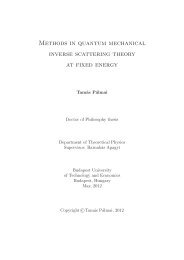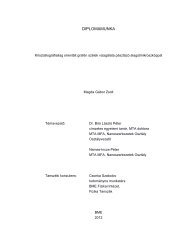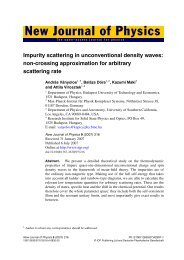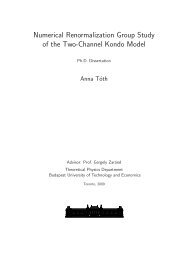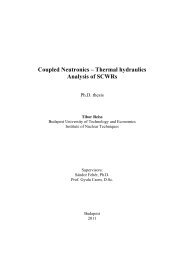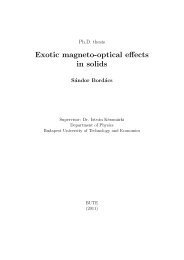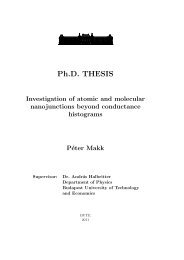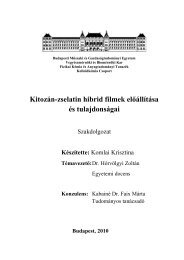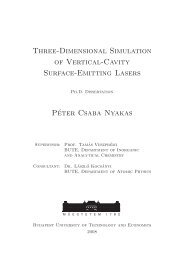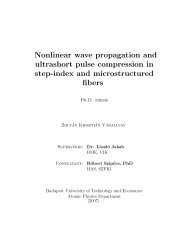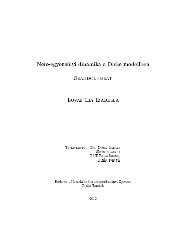Ph.D. THESIS Multipolar ordering in f-electron systems
Ph.D. THESIS Multipolar ordering in f-electron systems
Ph.D. THESIS Multipolar ordering in f-electron systems
Create successful ePaper yourself
Turn your PDF publications into a flip-book with our unique Google optimized e-Paper software.
Chapter 2 Overview of the Theoretical Background 33<br />
tibility χ 3 . In fact, URu 2 Si 2 was found to develop a weak antiferromagnetic<br />
moment ≤ 0.03µ B at, or at least near T N . However, this weak magnetism certa<strong>in</strong>ly<br />
cannot be the order parameter of the transition: it could not account<br />
for the scale of the phenomenon (the ∼ O(ln2) entropy change).<br />
Figure 2.7: Left: The l<strong>in</strong>ear and the non-l<strong>in</strong>ear susceptibility of URu 2 Si 2 as a function<br />
of the temperature [56], [65] Right: The specific heat as a function of the temperature.<br />
Large anomaly at T = 17.5K <strong>in</strong>dicates the phase transition [65].<br />
The search for the non-magnetic primary order parameter began decades<br />
ago. Though (as we have discussed) there are quite a few f-<strong>electron</strong> <strong>systems</strong><br />
with difficult-to-identify order parameters, the case of URu 2 Si 2 became<br />
known as perhaps the most famous case of ”hidden” order. Though there<br />
were many attempts to identify it, neither of the proposed solutions seemed<br />
to satisfy all the criteria. In Chapter 5 of the present thesis, I describe the<br />
latest attempt to expla<strong>in</strong> the nature of URu 2 Si 2 .<br />
As to the weak antiferromagnetism, earlier observations of its samplequality-dependence<br />
gave rise to the doubt that it may be extr<strong>in</strong>sic. Much<br />
of recent experimental evidence po<strong>in</strong>ts to the fact that it is only a m<strong>in</strong>ority<br />
phase of the samples which is antiferromagnetic. We take this po<strong>in</strong>t of view.<br />
It follows that the hidden primary order is completely non-magnetic, and at<br />
zero field, it does not <strong>in</strong>duce any k<strong>in</strong>d of magnetism. U 4+ : 5f 2 shells are<br />
iso<strong>electron</strong>ic with 4f 2 . In this sense, the problem of U <strong>systems</strong> has a lot<br />
of parallels to that of Pr <strong>systems</strong>. However, the total number of different<br />
<strong>order<strong>in</strong>g</strong> schemes supported by J = 4 is huge. URu 2 Si 2 is completely different<br />
from the Pr <strong>systems</strong> mentioned <strong>in</strong> the previous subsection. The crystal<br />
field act<strong>in</strong>g on the U 4+ ion is tetragonal, so the n<strong>in</strong>efold degeneracy is split<br />
ion contributions to χ.



